
Begonia is a genus of perennial flowering plants in the family Begoniaceae. The genus contains more than 2,000 different plant species. The Begonias are native to moist subtropical and tropical climates. Some species are commonly grown indoors as ornamental houseplants in cooler climates. In cooler climates some species are cultivated outside in summertime for their bright colorful flowers, which have sepals but no petals.

Variegation is the appearance of differently coloured zones in the leaves and sometimes the stems and fruit of plants. Species with variegated individuals are sometimes found in the understory of tropical rainforests, and this habitat is the source of a number of variegated houseplants. Variegation is caused by mutations that affect chlorophyll production or by viruses, such as mosaic viruses, which have been studied by scientists. The striking look of variegated plants is desired by many gardeners, and some have deliberately tried to induce it for aesthetic purposes. There are a number of gardening books about variegated plants, and some gardening societies specialize in them.

Begoniaceae is a family of flowering plants with two genera and about 2040 species occurring in the subtropics and tropics of both the New World and Old World. All but one of the species are in the genus Begonia. There have been many recent discoveries of species in the genus Begonia, such as Begonia truncatifolia which is endemic to San Vincente, Palawan. B. truncatifolia is smaller in size than other species of the genus Begonia and this new species is proposed Critically Endangered by standards set by the IUCN. The only other genus in the family, Hillebrandia, is endemic to the Hawaiian Islands and has a single species. Phylogenetic work supports Hillebrandia as the sister taxon to the rest of the family. The genus Symbegonia was reduced to a section of Begonia in 2003, as molecular phylogenies had shown it to be derived from within that genus. Members of the genus Begonia are well-known and popular houseplants.

Quercus turbinella is a North American species of oak known by the common names shrub oak, turbinella oak, shrub live oak, and gray oak. It is native to Arizona, California, New Mexico, Utah, Colorado, and Nevada in the western United States. It also occurs in northern Mexico.

Quercus grisea, commonly known as the gray oak, shin oak or scrub oak, is a North American species deciduous or evergreen shrub or medium-sized tree in the white oak group. It is native to the mountains of the southwestern United States and northern Mexico. It hybridises with four other oak species where the ranges overlap, the Arizona white oak (Q. arizonica), the Gambel oak (Q. gambelii), the Mohr oak (Q. mohriana) and the sandpaper oak (Q. pungens).

Begonia palmata is a species of plant in the genus Begonia of the family Begoniaceae. It is a small herb of height 20–90 cm tall. It is found in moist places, next to streams or under the shade. It is found in many parts of Asia, including eastern Himalayas.

Begonia carolineifolia, the palm leaf begonia, palmate begonia or hand begonia, is a species of flowering plant in the genus Begonia native to central and southern Mexico and northern Central America. It has gained the Royal Horticultural Society's Award of Garden Merit.

Begonia dregei, the maple leaf begonia or grape-leaf begonia, is a species of flowering plant in the genus Begonia native to South Africa. It has gained the Royal Horticultural Society's Award of Garden Merit.

Begonia luxurians, the palm leaf begonia, is an evergreen perennial plant with large drooping palmate leaves, each divided into many narrow leaflets, sprouting from bright red erect stems. Small white or yellow scented flowers appear above the leaves in spring and summer. In favourable conditions, plants can reach 2.5 m (8.2 ft) in height. It is native to southeastern Brazil.
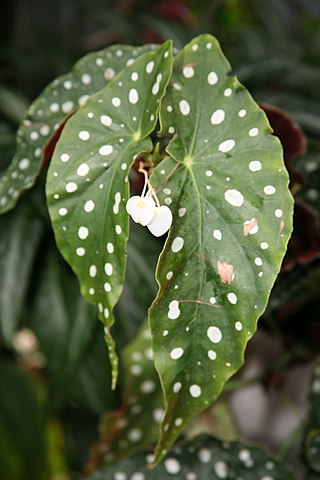
Begonia maculata, the polka dot begonia, is a species of begonia native to southeast Brazil. It grows naturally in the Atlantic rainforest, with occurrences confirmed in the Brazilian states of Espírito Santo and Rio de Janeiro. It has been introduced into Mexico, Cuba, the Dominican Republic, and Argentina.

Begonia rex, the king begonia, is a species of flowering plant in the family Begoniaceae. It is found from Arunachal Pradesh to southeast China, and has been introduced to Bangladesh, Cuba, and Hispaniola. It is a parent to over 500 cultivars in the Begonia Rex Cultorum Group of houseplants. Other parents in the multitude of crosses made during the creation of the Group include Begonia annulata, B. cathayana, B. decora, B. diadema, B. dregei, B. grandis, B. hatacoa, B. palmata, and B. xanthina.

Begonia heracleifolia, the star begonia, is a species of flowering plant in the family Begoniaceae. It is native to Mexico and northern Central America, and has been introduced to Cuba, Hispaniola, Puerto Rico, and Trinidad and Tobago. A widespread species that is adapted to drought, it possesses considerable genetic and morphological variation, particularly in leaf shape and patterning.
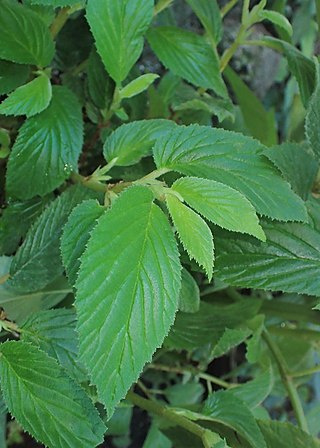
Begonia ulmifolia, the elm-leaf begonia, is a species of flowering plant in the family Begoniaceae. It is native to South America; Trinidad and Tobago, Venezuela, the Guianas, and eastern Brazil, and introduced to Mauritius, Réunion, and the Seychelles in the Indian Ocean. Cultivated for its ornamental foliage more than its flowers, it is suitable for green roofs in hot and humid areas.
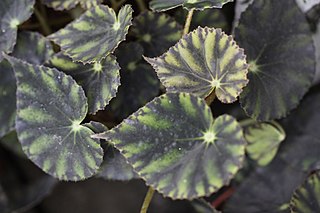
Begonia mazae is a species of flowering plant in the family Begoniaceae, native to southeastern Mexico. In its tropical forest habitat it grows in extremely dense shade.
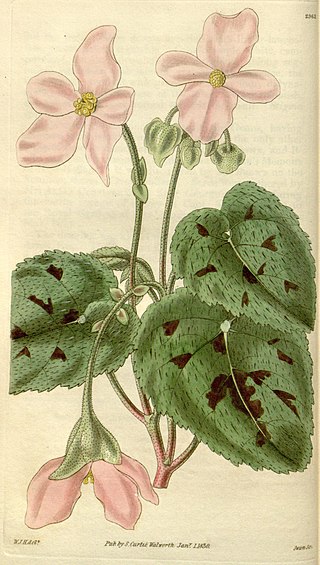
Begonia picta, the painted leaf begonia, is a widespread species of flowering plant in the family Begoniaceae, native to the Himalayan region. It grows relatively high up in the foothills of the Himalayas, typically on shady slopes and moist ledges, and requires high humidity and warm temperatures in cultivation.
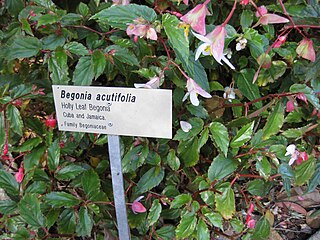
Begonia acutifolia, the holly-leaf begonia, is a species of flowering plant in the family Begoniaceae, native to Cuba and Jamaica, and introduced to Saint Helena. Shade tolerant, it is kept as a house plant, or outside in USDA hardiness zone 9b or warmer.
Physalis grisea is a species of flowering plant in the nightshade family known by common names including strawberry ground-cherry, downy ground-cherry, and strawberry-tomato in English. The name downy ground-cherry is due to the soft hairs that give the plant a gray cast. This downy gray coloration is the origin of the specific epithet grisea. Physalis grisea is native to northeastern North America.
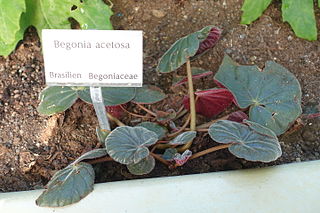
Begonia acetosa is a species of flowering plant in the family Begoniaceae, native to southeastern Brazil. It is used to create new begonia hybrids due to its attractive foliage. Begonia acetosa has been cultivated in the United States since 1946, when Mulford B. Foster introduced the species from forested mountains near Rio de Janeiro. It was first described in 1831 by José Mariano de Conceição Vellozo. The specific epithet acetosa means 'acid' or 'sour', referring to the rhubarb-like taste of its leaves.
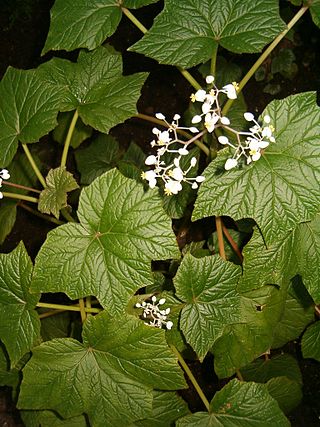
Begonia reniformis, the grape leaf begonia or grapeleaf begonia, is a species of flowering plant in the family Begoniaceae. It is native to central and eastern Brazil, and has been introduced to Hawaii. A perennial shrub with white flowers, it can reach 1.5 m (5 ft) tall.
Begonia thiemei, the palm leaf begonia, is a species of flowering plant in the family Begoniaceae, native to southeastern Mexico, Guatemala, and Honduras. A perennial reaching 20 cm (8 in) tall but spreading to 46 cm (18 in) wide, it is cultivated for its palmate foliage. A cultivar, 'Purpurea', is often called Begonia macdougallii var. purpurea in the trade.



















